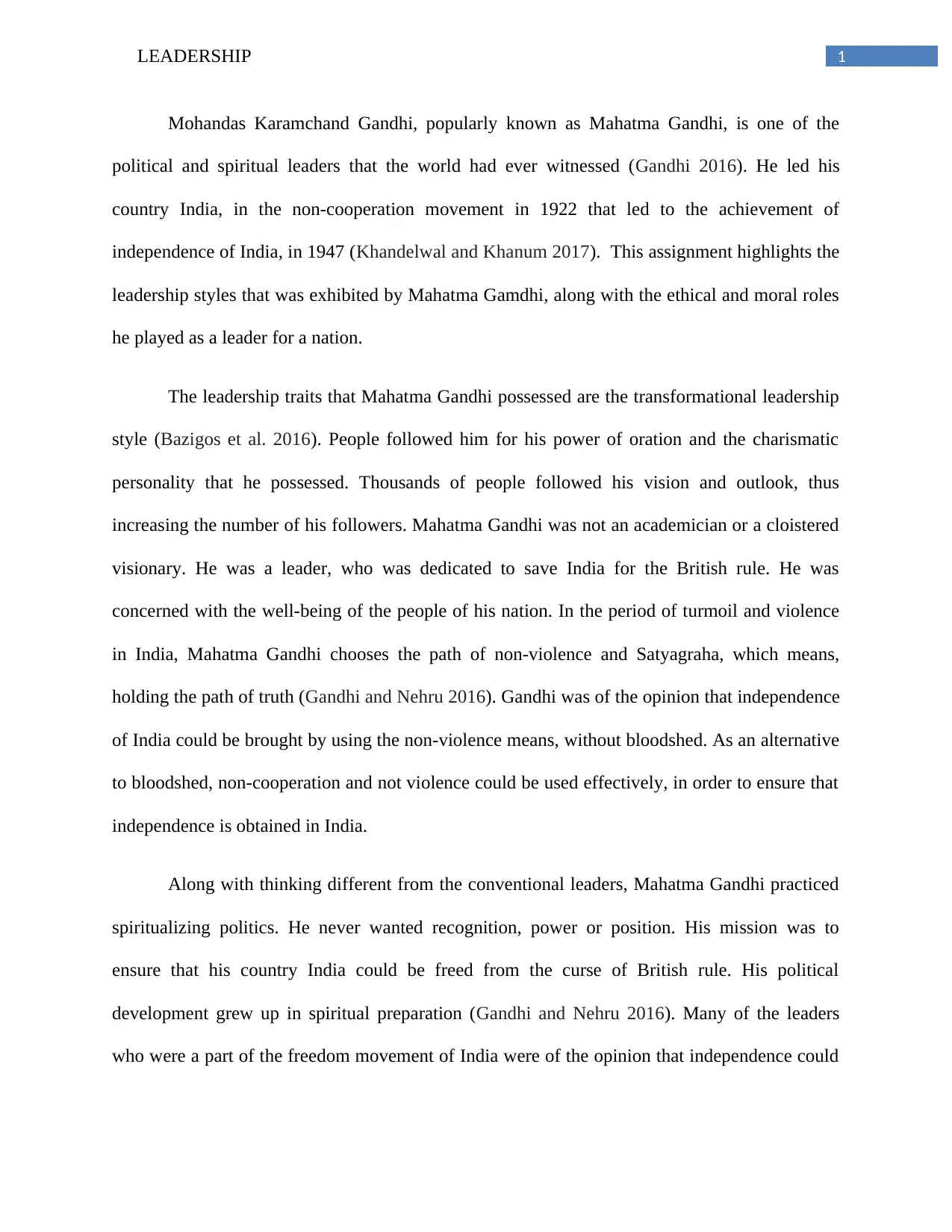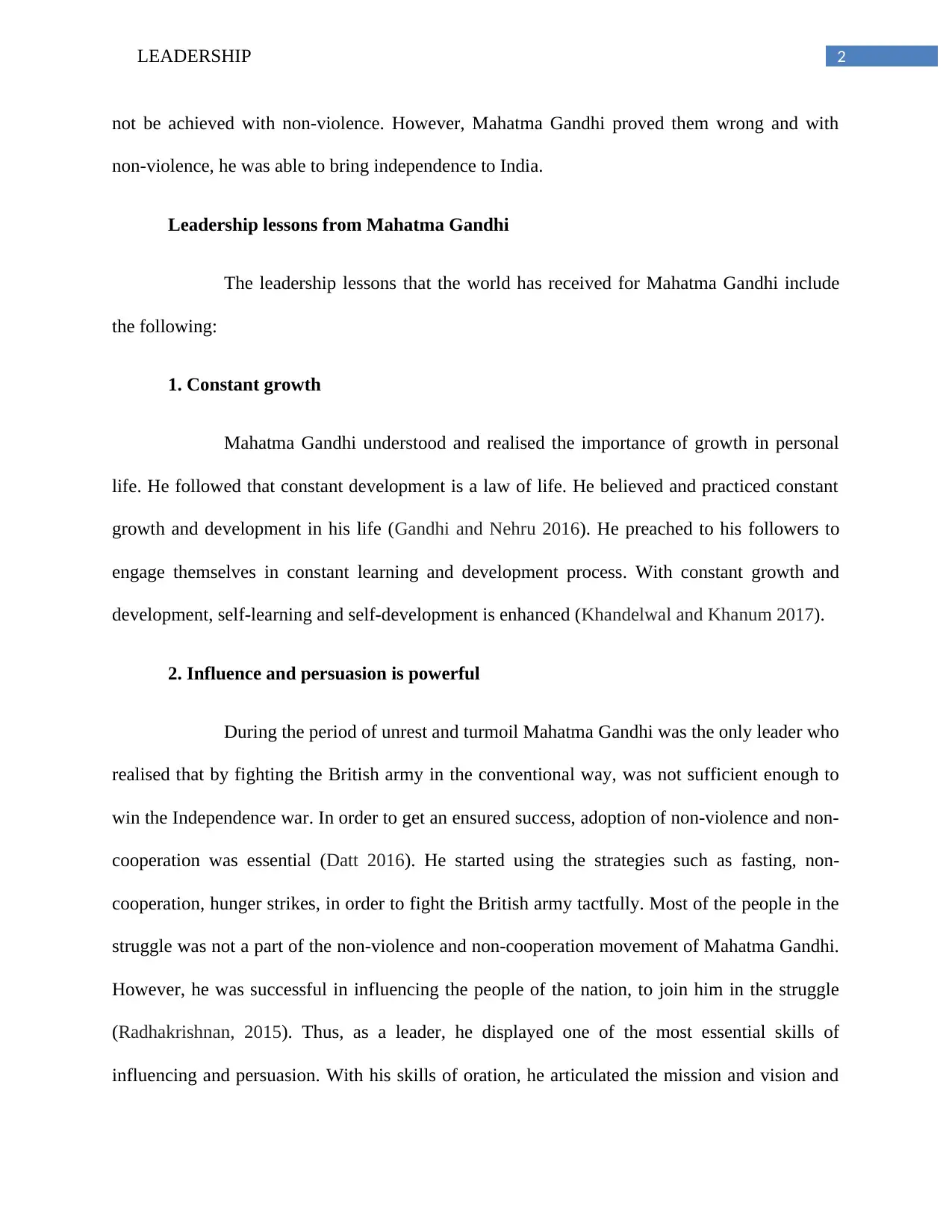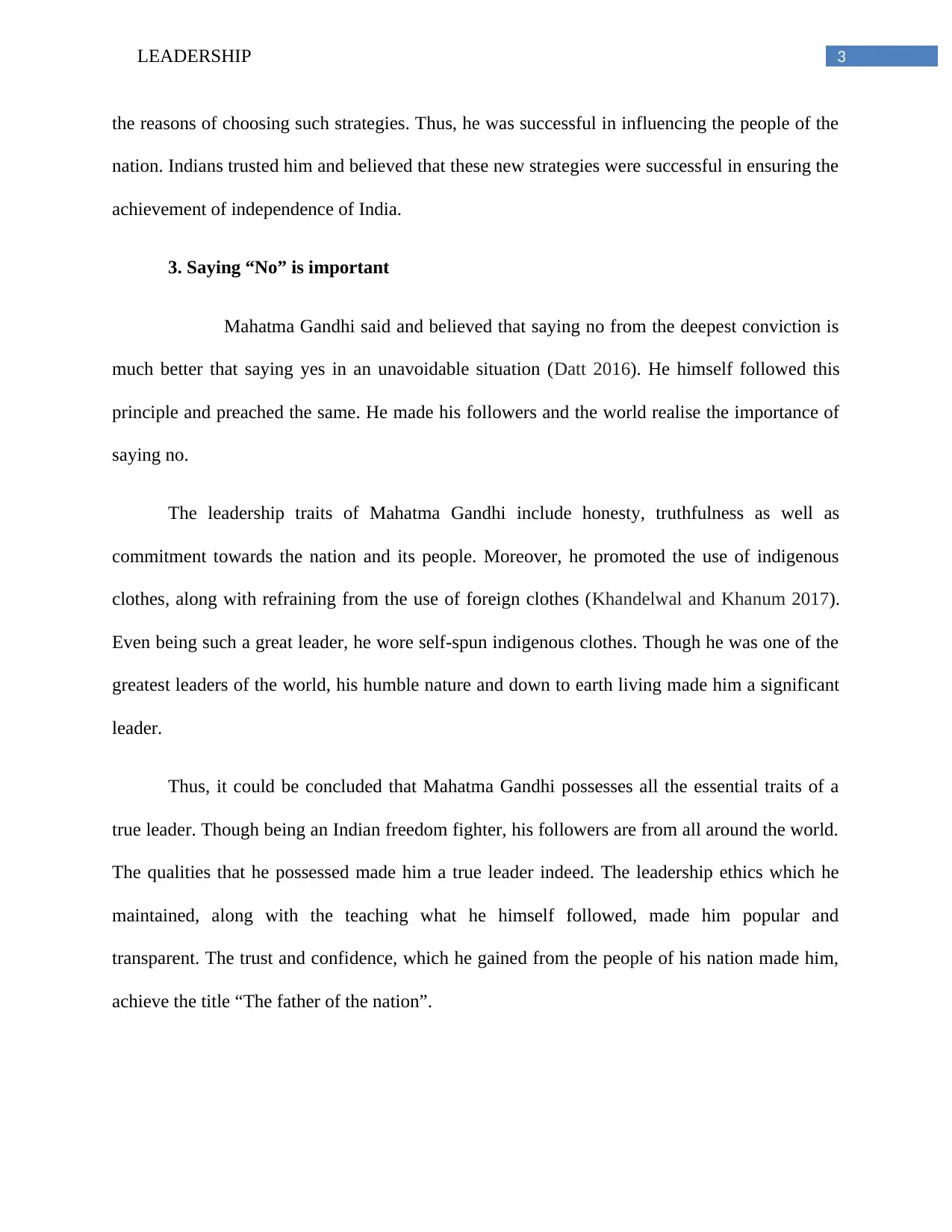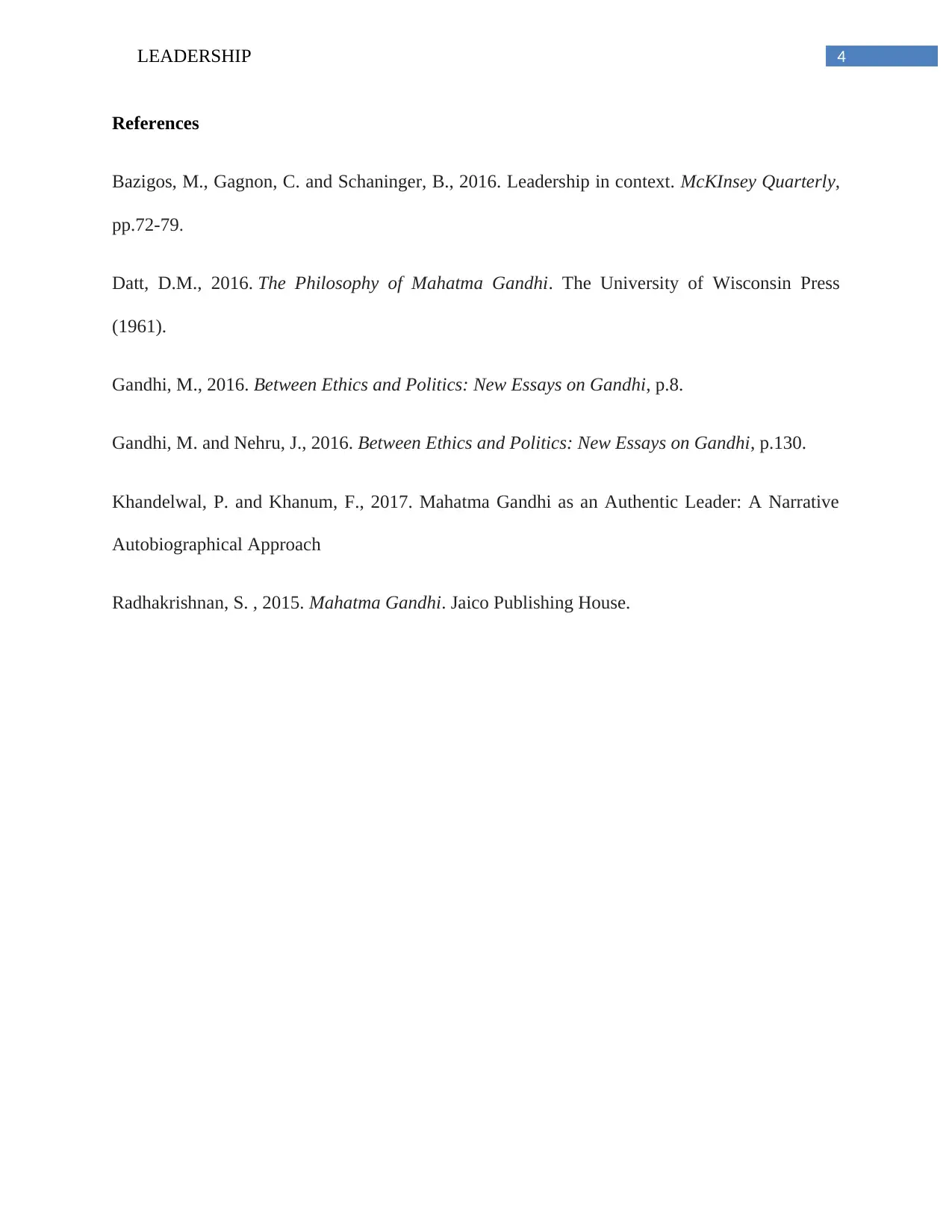Analysis of Mahatma Gandhi's Leadership Qualities and Styles
VerifiedAdded on 2020/02/24
|5
|1053
|126
Essay
AI Summary
This essay examines the leadership style of Mahatma Gandhi, focusing on his transformational approach and ethical principles. It highlights his role in India's independence movement, emphasizing his use of non-violent methods like Satyagraha and non-cooperation. The essay analyzes key leadership lessons from Gandhi's life, including the importance of constant growth, influence and persuasion, and the significance of saying "no." It also explores his commitment to truthfulness, honesty, and his humble nature. The analysis underscores Gandhi's qualities as a true leader, respected globally for his ethics and transparency, which earned him the title "The father of the nation." The essay references various sources to support its claims.

Running head: LEADERSHIP
Leadership
Name of the student:
Name of the University:
Author Note:
Leadership
Name of the student:
Name of the University:
Author Note:
Paraphrase This Document
Need a fresh take? Get an instant paraphrase of this document with our AI Paraphraser

1LEADERSHIP
Mohandas Karamchand Gandhi, popularly known as Mahatma Gandhi, is one of the
political and spiritual leaders that the world had ever witnessed (Gandhi 2016). He led his
country India, in the non-cooperation movement in 1922 that led to the achievement of
independence of India, in 1947 (Khandelwal and Khanum 2017). This assignment highlights the
leadership styles that was exhibited by Mahatma Gamdhi, along with the ethical and moral roles
he played as a leader for a nation.
The leadership traits that Mahatma Gandhi possessed are the transformational leadership
style (Bazigos et al. 2016). People followed him for his power of oration and the charismatic
personality that he possessed. Thousands of people followed his vision and outlook, thus
increasing the number of his followers. Mahatma Gandhi was not an academician or a cloistered
visionary. He was a leader, who was dedicated to save India for the British rule. He was
concerned with the well-being of the people of his nation. In the period of turmoil and violence
in India, Mahatma Gandhi chooses the path of non-violence and Satyagraha, which means,
holding the path of truth (Gandhi and Nehru 2016). Gandhi was of the opinion that independence
of India could be brought by using the non-violence means, without bloodshed. As an alternative
to bloodshed, non-cooperation and not violence could be used effectively, in order to ensure that
independence is obtained in India.
Along with thinking different from the conventional leaders, Mahatma Gandhi practiced
spiritualizing politics. He never wanted recognition, power or position. His mission was to
ensure that his country India could be freed from the curse of British rule. His political
development grew up in spiritual preparation (Gandhi and Nehru 2016). Many of the leaders
who were a part of the freedom movement of India were of the opinion that independence could
Mohandas Karamchand Gandhi, popularly known as Mahatma Gandhi, is one of the
political and spiritual leaders that the world had ever witnessed (Gandhi 2016). He led his
country India, in the non-cooperation movement in 1922 that led to the achievement of
independence of India, in 1947 (Khandelwal and Khanum 2017). This assignment highlights the
leadership styles that was exhibited by Mahatma Gamdhi, along with the ethical and moral roles
he played as a leader for a nation.
The leadership traits that Mahatma Gandhi possessed are the transformational leadership
style (Bazigos et al. 2016). People followed him for his power of oration and the charismatic
personality that he possessed. Thousands of people followed his vision and outlook, thus
increasing the number of his followers. Mahatma Gandhi was not an academician or a cloistered
visionary. He was a leader, who was dedicated to save India for the British rule. He was
concerned with the well-being of the people of his nation. In the period of turmoil and violence
in India, Mahatma Gandhi chooses the path of non-violence and Satyagraha, which means,
holding the path of truth (Gandhi and Nehru 2016). Gandhi was of the opinion that independence
of India could be brought by using the non-violence means, without bloodshed. As an alternative
to bloodshed, non-cooperation and not violence could be used effectively, in order to ensure that
independence is obtained in India.
Along with thinking different from the conventional leaders, Mahatma Gandhi practiced
spiritualizing politics. He never wanted recognition, power or position. His mission was to
ensure that his country India could be freed from the curse of British rule. His political
development grew up in spiritual preparation (Gandhi and Nehru 2016). Many of the leaders
who were a part of the freedom movement of India were of the opinion that independence could

2LEADERSHIP
not be achieved with non-violence. However, Mahatma Gandhi proved them wrong and with
non-violence, he was able to bring independence to India.
Leadership lessons from Mahatma Gandhi
The leadership lessons that the world has received for Mahatma Gandhi include
the following:
1. Constant growth
Mahatma Gandhi understood and realised the importance of growth in personal
life. He followed that constant development is a law of life. He believed and practiced constant
growth and development in his life (Gandhi and Nehru 2016). He preached to his followers to
engage themselves in constant learning and development process. With constant growth and
development, self-learning and self-development is enhanced (Khandelwal and Khanum 2017).
2. Influence and persuasion is powerful
During the period of unrest and turmoil Mahatma Gandhi was the only leader who
realised that by fighting the British army in the conventional way, was not sufficient enough to
win the Independence war. In order to get an ensured success, adoption of non-violence and non-
cooperation was essential (Datt 2016). He started using the strategies such as fasting, non-
cooperation, hunger strikes, in order to fight the British army tactfully. Most of the people in the
struggle was not a part of the non-violence and non-cooperation movement of Mahatma Gandhi.
However, he was successful in influencing the people of the nation, to join him in the struggle
(Radhakrishnan, 2015). Thus, as a leader, he displayed one of the most essential skills of
influencing and persuasion. With his skills of oration, he articulated the mission and vision and
not be achieved with non-violence. However, Mahatma Gandhi proved them wrong and with
non-violence, he was able to bring independence to India.
Leadership lessons from Mahatma Gandhi
The leadership lessons that the world has received for Mahatma Gandhi include
the following:
1. Constant growth
Mahatma Gandhi understood and realised the importance of growth in personal
life. He followed that constant development is a law of life. He believed and practiced constant
growth and development in his life (Gandhi and Nehru 2016). He preached to his followers to
engage themselves in constant learning and development process. With constant growth and
development, self-learning and self-development is enhanced (Khandelwal and Khanum 2017).
2. Influence and persuasion is powerful
During the period of unrest and turmoil Mahatma Gandhi was the only leader who
realised that by fighting the British army in the conventional way, was not sufficient enough to
win the Independence war. In order to get an ensured success, adoption of non-violence and non-
cooperation was essential (Datt 2016). He started using the strategies such as fasting, non-
cooperation, hunger strikes, in order to fight the British army tactfully. Most of the people in the
struggle was not a part of the non-violence and non-cooperation movement of Mahatma Gandhi.
However, he was successful in influencing the people of the nation, to join him in the struggle
(Radhakrishnan, 2015). Thus, as a leader, he displayed one of the most essential skills of
influencing and persuasion. With his skills of oration, he articulated the mission and vision and
⊘ This is a preview!⊘
Do you want full access?
Subscribe today to unlock all pages.

Trusted by 1+ million students worldwide

3LEADERSHIP
the reasons of choosing such strategies. Thus, he was successful in influencing the people of the
nation. Indians trusted him and believed that these new strategies were successful in ensuring the
achievement of independence of India.
3. Saying “No” is important
Mahatma Gandhi said and believed that saying no from the deepest conviction is
much better that saying yes in an unavoidable situation (Datt 2016). He himself followed this
principle and preached the same. He made his followers and the world realise the importance of
saying no.
The leadership traits of Mahatma Gandhi include honesty, truthfulness as well as
commitment towards the nation and its people. Moreover, he promoted the use of indigenous
clothes, along with refraining from the use of foreign clothes (Khandelwal and Khanum 2017).
Even being such a great leader, he wore self-spun indigenous clothes. Though he was one of the
greatest leaders of the world, his humble nature and down to earth living made him a significant
leader.
Thus, it could be concluded that Mahatma Gandhi possesses all the essential traits of a
true leader. Though being an Indian freedom fighter, his followers are from all around the world.
The qualities that he possessed made him a true leader indeed. The leadership ethics which he
maintained, along with the teaching what he himself followed, made him popular and
transparent. The trust and confidence, which he gained from the people of his nation made him,
achieve the title “The father of the nation”.
the reasons of choosing such strategies. Thus, he was successful in influencing the people of the
nation. Indians trusted him and believed that these new strategies were successful in ensuring the
achievement of independence of India.
3. Saying “No” is important
Mahatma Gandhi said and believed that saying no from the deepest conviction is
much better that saying yes in an unavoidable situation (Datt 2016). He himself followed this
principle and preached the same. He made his followers and the world realise the importance of
saying no.
The leadership traits of Mahatma Gandhi include honesty, truthfulness as well as
commitment towards the nation and its people. Moreover, he promoted the use of indigenous
clothes, along with refraining from the use of foreign clothes (Khandelwal and Khanum 2017).
Even being such a great leader, he wore self-spun indigenous clothes. Though he was one of the
greatest leaders of the world, his humble nature and down to earth living made him a significant
leader.
Thus, it could be concluded that Mahatma Gandhi possesses all the essential traits of a
true leader. Though being an Indian freedom fighter, his followers are from all around the world.
The qualities that he possessed made him a true leader indeed. The leadership ethics which he
maintained, along with the teaching what he himself followed, made him popular and
transparent. The trust and confidence, which he gained from the people of his nation made him,
achieve the title “The father of the nation”.
Paraphrase This Document
Need a fresh take? Get an instant paraphrase of this document with our AI Paraphraser

4LEADERSHIP
References
Bazigos, M., Gagnon, C. and Schaninger, B., 2016. Leadership in context. McKInsey Quarterly,
pp.72-79.
Datt, D.M., 2016. The Philosophy of Mahatma Gandhi. The University of Wisconsin Press
(1961).
Gandhi, M., 2016. Between Ethics and Politics: New Essays on Gandhi, p.8.
Gandhi, M. and Nehru, J., 2016. Between Ethics and Politics: New Essays on Gandhi, p.130.
Khandelwal, P. and Khanum, F., 2017. Mahatma Gandhi as an Authentic Leader: A Narrative
Autobiographical Approach
Radhakrishnan, S. , 2015. Mahatma Gandhi. Jaico Publishing House.
References
Bazigos, M., Gagnon, C. and Schaninger, B., 2016. Leadership in context. McKInsey Quarterly,
pp.72-79.
Datt, D.M., 2016. The Philosophy of Mahatma Gandhi. The University of Wisconsin Press
(1961).
Gandhi, M., 2016. Between Ethics and Politics: New Essays on Gandhi, p.8.
Gandhi, M. and Nehru, J., 2016. Between Ethics and Politics: New Essays on Gandhi, p.130.
Khandelwal, P. and Khanum, F., 2017. Mahatma Gandhi as an Authentic Leader: A Narrative
Autobiographical Approach
Radhakrishnan, S. , 2015. Mahatma Gandhi. Jaico Publishing House.
1 out of 5
Related Documents
Your All-in-One AI-Powered Toolkit for Academic Success.
+13062052269
info@desklib.com
Available 24*7 on WhatsApp / Email
![[object Object]](/_next/static/media/star-bottom.7253800d.svg)
Unlock your academic potential
Copyright © 2020–2025 A2Z Services. All Rights Reserved. Developed and managed by ZUCOL.





